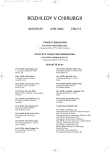Intracranial Meningiomas; Standard Diagnostic Procedure and Results of Surgical Treatment
Nitrolební meningiomy; standardní diagnostický postup a výsledky operační léčby
Cílem této studie je nalezení radiologických parametrů, které nepřímo informují o invazivním růstu meningiomu a mohou tak předpovídat pravděpodobné riziko vzniku pooperačního neurologického deficitu. Soubor tvoří 40 po sobě jdoucích dospělých pacientů ve srovnatelném celkovém stavu (věk 18–75 let, KRS 70–100, ASA 1–2) s meningiomy, které celým svým objemem atakují pouze mozkovou tkáň. Z výsledků vyplývá, že nepříznivé parametry, které predikují vznik pooperačního neurologického deficitu jsou růst meningiomu v elokventní oblasti a přítomnost peritumorálního edému. Příznivé parametry, které predikují, že neurologický deficit nevznikne jsou durální typ zásobení, viditelná bariéra mezi mozkem a nádorem, růst meningiomu v non-elokventní oblasti a absence peritumorálního edému. Jsou-li přítomné poslední dva jmenované parametry, není podle výsledků studie nutné vystavovat pacienta riziku invazivní selektivní angiografie.
Klíčová slova:
intrakraniální meningiom – elokvence – peritumorální edém – bariéra mezi mozkem a nádorem – durální typ vaskularizace
Authors:
P. Kozler; V. Beneš; D. Netuka; F. Kramář; F. Charvát 1
Authors‘ workplace:
Neurochirurgická klinika l. LF UK a ÚVN, Subkatedra neurochirurgie IPVZ Praha, přednosta: plk.
prof. MUDr. V. Beneš, DrSc.
; Radiologické oddělení ÚVN Praha, přednosta: pplk. MUDr. F. Charvát
1
Published in:
Rozhl. Chir., 2006, roč. 85, č. 9, s. 431-435.
Category:
Monothematic special - Original
Overview
The aim of the study is to define radiological parameters which may indirectly indicate invasive expansion of a meningioma and thus forecast potential risks of postoperative neurological deficits. The study group includes 40 adult patients in comparable physical conditions (age 18–75, CRS 70–100, ASA 1–2) with meningiomas, affecting the brain tissue only. The results indicate that unfavorable parametres, predicting potential postoperative neurological deficits include: growth of a meningioma in eloquent regions and presence of a peritumoral oedema. Positive parametres, indicating that no neurological deficit would arise, include: dural supply, visible brain-tumor barrier, non-eloquent location of a meningioma and absence of a peritumoral oedema. The study results suggest that provided the two last parametres are present, a patient need not be exposed to risks of invasive selective angiography.
Key words:
intracranial meningioma – eloquency – peritumoral oedema – brain-tumor barrier – dural vascularization type
Labels
Surgery Orthopaedics Trauma surgeryArticle was published in
Perspectives in Surgery

2006 Issue 9
- Metamizole vs. Tramadol in Postoperative Analgesia
- Metamizole at a Glance and in Practice – Effective Non-Opioid Analgesic for All Ages
- Possibilities of Using Metamizole in the Treatment of Acute Primary Headaches
Most read in this issue
- Crossectomy – the Most Important Step in Varices Surgery
- Neurostimulation – Prevention of Injuries to the Nervus Laryngeus Recurrens During Thyreoidectomy
- Robotic Laparoscopic Cholecystectomy
- Splenosis in the Abdominal Wall Subcutis
